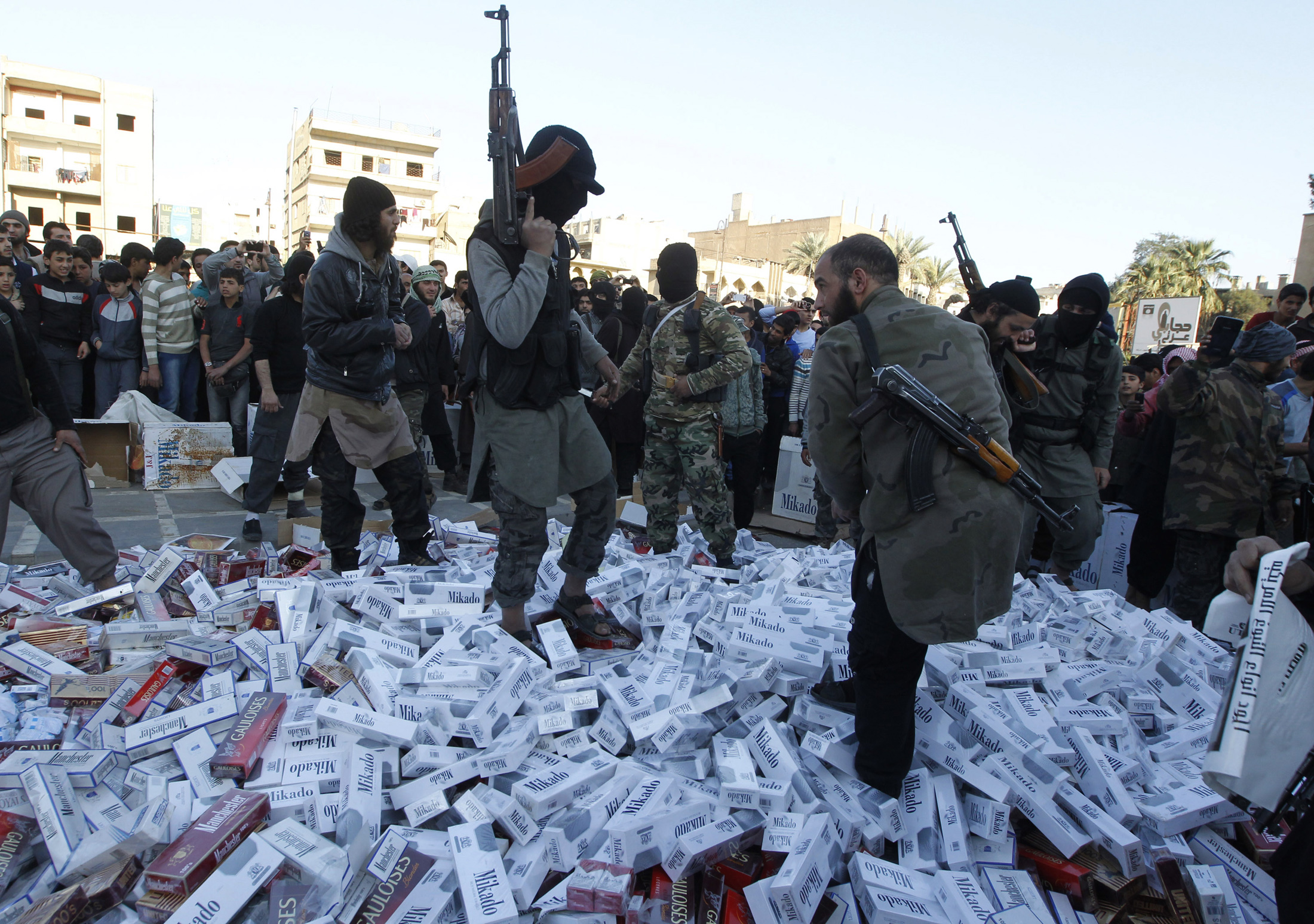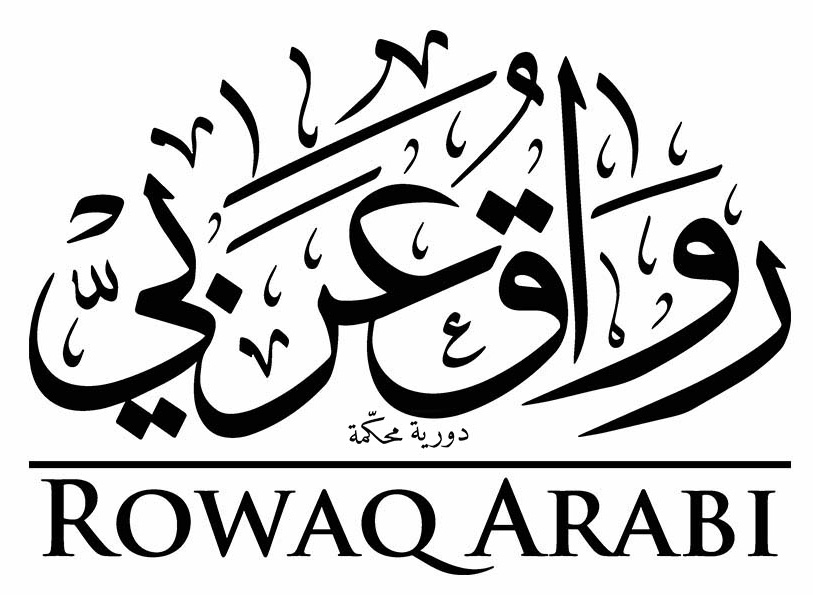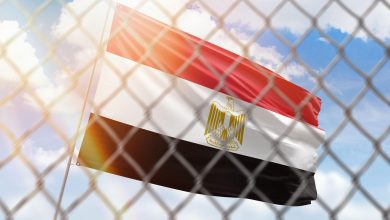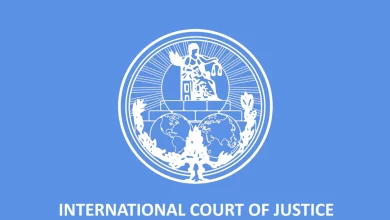Views: How the Assad Regime Helped Create, Support, and Perpetuate ‘ISIS’?

Citation: Alrefaai, Laila (2021) ‘Views: How the Assad Regime Helped Create, Support, and Perpetuate ‘ISIS’?’, Rowaq Arabi 26 (3), pp. 39-46. https://doi.org/10.53833/KNMG9677
On 16 November 1986, on the sixteenth anniversary of the so-called Corrective Movement,[1] Syrian president Hafez al-Assad strenuously denied that Damascus had been involved in any ‘terrorist’[2] activity or supported any terrorist movement. On the contrary, his regime supported ‘resistance against occupation and all national liberation movement’. According to Assad, the ‘real terrorists’ were then American president Ronald Reagan and British prime minister Margaret Thatcher, who had imposed diplomatic and economic sanctions against the Syrian government, accusing it of supporting terrorism.[3]
Thirty-five years after that speech, Hafez’s son Bashar gave a speech while taking the presidential oath of office after winning 95.1 per cent of votes in an election widely described as a farce.[4] Terrorism was also a theme of Bashar’s speech. ‘Syria’s problem is terrorism’, he said, adding that the priority in his coming term in office would be ‘to liberate remaining […] terrorists and their Turkish and American sponsors’.[5]
The statements of both the father and the son, though decades apart, were just two episodes in a long-running rhetorical battle and proxy war between Syria and the West over the former’s relationship to terrorism—a war that has been on-going since the United States Department of State designated Syria a state sponsor of terrorism in late 1979.[6] The war has raged for over four decades, going through peaks and troughs, first under Hafez al-Assad, then Bashar after he assumed power in 2000, and even through the Syrian revolution to the present day.
This paper looks closely at the Syrian regime’s relationship with terrorism in the period from 2011 to 2021, first contextualising this relationship by offering a brief historical review of the regime’s ties to movements and organisations classified as terrorist. It finds that the regime has exploited and instrumentalised terrorism as a policy since Hafez al-Assad’s rise to power, as part of a bloody survival strategy. This policy has persisted to the present day, as seen specifically in the Syrian regime’s ties to the Islamic State (Daesh), which the regime used to strike out at its adversaries and pressure the West in order to maintain power.
The Arsonist and the Fire-fighter (1979–2003)
Perhaps the pithiest description of the relationship between terrorism and the Assad regime—established under the father and continued by the son—is that given by Middle East expert Michael Doran: ‘Ever since the 1980’s, Syria has played this game of being both the arsonist and the fire department’.[7] In fact, the Assad regime’s ties with these organisations are more complicated. Not always friendly and never fixed, the relationship is a dynamic one that shifts with changing conditions and interests. What has not changed, however, is the reality of this strategy on the part of the regime, as evidenced, for example, by Syria’s continued presence over the years in the declassified terrorism reviews released by the US Central Intelligence Agency.[8]
In contrast, the positions and politics of the organisations and groups that have received regime support vary. They include Palestinian movements, from Islamist to nationalist to leftist, and the Lebanese Hezbollah, as well as a number of designated terrorist groups in the Middle East like the Kurdistan Workers’ Party (PKK), the Japanese Red Army, and notorious terrorists like Ilich Ramirez Sanchez (aka Carlos the Jackal).[9] The regime’s propaganda apparatus justifies these policies with rhetoric about resistance, support for global liberation movements, and anti-imperialism, while also affirming the regime’s counterterrorist bona fides and branding its enemies as terrorists.[10]
The regime’s links with such organisations were never static. It acted to undermine and contain Palestinian movements as much as it supported them, and it similarly encouraged Hezbollah while simultaneously working to curtail it. It hosted Iraqi insurgents against the American occupation then arrested and extradited them.[11] PKK founder Abdullah Ocalan is perhaps the best example of such about-faces. Having trained fighters and directed his combat operations against Turkey from Syria for two decades, Ocalan was suddenly expelled by Hafez al-Assad in 1998 and ultimately detained by the Turkish authorities.[12]
This dynamic can be explained by looking at the two main objectives of these relationships for the Syrian regime: 1) to indirectly target and strike local, regional, and international adversaries, for both ideological reasons (for example, to boost its own legitimacy in the resistance against Israel) or for purely political and strategic reasons; and 2) to present itself to the West as an indispensible part of any solution, not only by showing its desire to contain the terrorist organisations that pose a threat to the West, such as al-Qaeda and Daesh, but also by showing its very real ability to cut off support or turn over wanted fugitives, but at the right price.[13]
A New Neighbouring Front (2003–2011)
After the American occupation of Iraq in 2003, the Syrian government joined in the war next door with its same arsonist/fire-fighter strategy, often turning a blind eye to jihadis who had reached Syria and were training there before heading to Iraq and, less frequently, providing training itself and actively encouraging them to join the fray. From the first year of the war, as security checks on the Iraqi side of the border disappeared and Syria looked the other way, foreign fighters began joining al-Qaeda in Iraq, led by Abu Musaab al-Zarqawi. In the next decade, that organisation would develop into the most notorious terrorist group by far—Daesh—after receiving training at the Syrian border town of al-Bukamal.[14] This prompted the US Defence Intelligence Agency in October 2003 to call Syria ‘a major point of access’ for jihadis; in 2005, US military leaders described Syrian cooperation as ‘very unhelpful’.[15]
This situation persisted throughout the war. According to al-Qaeda’s Sinjar records, which were seized by American forces and studied by the Combating Terrorism Center at West Point as part of the Harmony Project, some 600 fighters entered Iraq through Syria in 2006–07 as the Syrian authorities attempted to penetrate and influence these networks.[16] The networks for moving these fighters in Syria were active, effective, and influential, run by people like Badran Turki Hishan Al Mezidi, known as Abu Ghadiyah, whom the US Treasury Department placed on the sanctions list in 2008.[17] The US State Department and General David Petraeus, the commander of American forces in Iraq, affirmed that the Syrian government, in particular Assad’s brother-in-law Assef Shawkat, had detailed knowledge of the network’s activities and its use of Syrian territory to move fighters and suicide bombers into Iraq.[18]
In 2010, the Syrian government admitted as much. As revealed by Wikileaks, during a meeting with officials from the US State Department and the Syrian Foreign Ministry, Ali Mamlouk, then director of General Intelligence and National Security and today a senior security advisor to Assad, told the assembled parties that ‘we don’t attack or kill them [terrorist groups] immediately. Instead, we embed ourselves in them and only at the opportune moment do we move’. Mamlouk then offered the regime’s security services to the Americans in exchange for reduced economic sanctions and an improved regional and international political status for the Syrian regime.[19]
In addition, according to recruits who went to Iraq and dissident Syrian intelligence officers, the Syrian authorities pushed enthusiastic individuals to head to Iraq, specifically by utilising sympathetic imams who were supported by the intelligence agency itself. The most well known of these by far was the preacher at the Tawayin Mosque in Aleppo, Mahmoud Qul Aghasi, known as Abu al-Qa’qa’, who was assassinated in 2007, likely by Syrian intelligence itself.[20] For the regime, this strategy had two goals: to pressure the West and extract the right price, as expressed explicitly by Ali Mamlouk, and to prolong the insurgency in Iraq and effectively bog down American forces in the morass, after which, it was hoped, it would abandon any ideas of regime change in Syria.[21]
With the exception of ideological recruits, many of the men who went to Iraq from Syria returned only to be arrested and imprisoned at the notorious Sednaya Prison, put there by the same intelligence agency that encouraged and facilitated their initial journey to Iraq. Domestically, this strategy enabled the regime to rid itself of jihadis—whether they ended up in Iraq or Sednaya—while on the international stage it demonstrated that the regime was effectively ‘combating terrorism’.[22] With time, the Sednaya Prison was transformed into a jihadi academy (before becoming a human abattoir after the revolution[23]). It was a five-star prison for jihadis, who were allowed to propagate their ideas within the prison and turn what had been overeager young men into true jihadi believers. At the same time, civil activists and leftists in the same prison were held in extremely harsh conditions, barred from even speaking to one another, according to Diab Sariya, a civil activist formerly imprisoned in Sednaya.[24] This policy would continue in another form after the eruption of the Syrian revolution, and the Sednaya generation would play a prominent role in the emergence of IS and the survival of Assad.
‘Either Assad or We Burn It All Down’ (2011–2021)
Just seven months after the start of the Syrian revolution, specifically on 29 October 2011, President Bashar al-Assad said in an interview with the London-based Daily Telegraph:
Syria is the hub now in this region. It is the faultline, and if you play with the ground you will cause an earthquake. Any problem in Syria will burn the whole region. If the plan is to divide Syria, that is to divide the whole region. Do you want to see another Afghanistan, or tens of Afghanistans?[25]
Under threat from the revolution, the survival strategy of the Assad regime came down to: either Assad, or we set fire to the whole region. This was the regional iteration of the same domestic strategy (Assad, or we burn the whole country down), based on fear-mongering around scenarios that made Assad look like the lesser evil, then fostering the conditions for the realisation of those same scenarios, thus making the dire predictions self-fulfilling, and solidifying Assad’s rule.[26]
This strategy was carried out under the supervision of the ‘crisis cell’, which included senior security commanders, among them Ali Mabrouk.[27] Then, in a continuation of this strategy, and following the model of Sednaya, Assad branded revolutionaries and peaceful protestors ‘terrorists’ and targeted them specifically for arrest and death while releasing hundreds of security prisoners accused of terrorism in a series of general amnesty orders, the most well known of which was Legislative Decree 61, issued on 31 May 2011.[28]
The people released by Assad were not only soldiers and fighters; at least nine of them became the leaders of jihadi groups (such as Ahrar al-Sham and the Nusra Front, now known as Hayat Tahrir al-Sham) and four of them went on to lead Daesh,[29] most famously Ali al-Shawakh, known as Abu Luqman.[30] Shawakh later became the governor of Raqqa, the capital of Daesh in Syria, and is responsible for numerous beheadings. Deeply involved in fundraising for the group, he was placed on the US sanctions list in 2015.[31]
Thanks to their prior connections and networking in prison, it did not take long—‘weeks, not even months’, according to one released prisoner[32]—for these figures to resume contact and organise outside of prison. Initially they set up small cells in areas across Syria. As it had during the Iraq war, starting in October 2011 the Syrian regime let Daesh leaders cross the borders in plain view, and unite and finance these small cells, culminating in the declaration of the Islamic State in Iraq and Syria in April 2013.[33]
The policy of studiously ignoring Daesh continued: as long as it focused its military efforts on areas under the control of the Free Syrian Army,[34] Daesh was free to expand its territory with virtually no interference from the Syrian regime. Noting in 2014 that the regime had not touched the Raqqa headquarters of Daesh while it continued to drop barrel bombs on Deraa, Aleppo, and Rif Damascus, former US ambassador to Syria Robert Ford caustically offered to provide Assad with directions to the Daesh headquarters if he was unaware of their location.[35] And it was not simply a matter of studious disregard. On several occasions, the regime bombed revolutionaries to cover for a military advance by Daesh, or to make it easier to besiege a particular region following a Daesh retreat.[36]
The expansion of Daesh served the regime’s narrative that it was fighting ‘terrorists’: alarmed by the spectre of Daesh, the West would then turn its attention away from the Syrian regime. At the same time, Daesh helped the regime suppress the Syrian revolution and revolutionaries, while leaving the matter of Daesh itself to Western powers. In addition, starting in 2014, when Daesh controlled vast swathes of the Deir al-Zor province—the site of Syria’s oil reserves—the regime began purchasing cheap oil from the organisation to resolve the burgeoning economic crisis that had resulted from sanctions. In turn, this prompted the European Union and United States to place several businessmen close to the regime on the sanctions list, among them George Haswani (2015), the middleman between the regime and Daesh,[37] and Muhammad al-Qatirji (2018).[38] By early 2017, oil sales to the Syrian regime were the biggest source of revenue for Daesh, ensuring its survival and expansion and financing its operations.[39] At the same time, Samer Foz, a businessman and war profiteer who was placed on European sanctions list in 2018, began buying and selling wheat with areas under Daesh control.[40]
As the organisation began to collapse in 2017 under the intensive allied military campaign, Daesh embraced a strategy of indirect engagement (hit-and-run), particularly deep in the Syrian desert where it still had multiple cells, dealing several heavy blows to the Syrian regime.[41] Nevertheless, the regime continued to exploit the situation, either to bolster its security and military policies in residential areas under its control in eastern Syria, or to push the international community towards its own favoured political resolution.[42]
In short, despite the international community’s success in temporarily eliminating the threat posed by Daesh, it failed utterly to confront the Syrian regime, which was a prime cause for the initial emergence of the threat and its subsequent continuation, and which later built its legitimacy and existence on eliminating this threat. As demonstrated here, Daesh would not have found such a firm foothold or survived and expanded were it not for the Syrian regime. The regime did not play simply a marginal, passive role by disregarding the organisation; regime support was foundational to its existence and facilitated its operation throughout its lifespan. Even worse, the regime was able to exploit the organisation to bolster its own political stature in the international community. By ‘fighting’ Daesh, the regime was able to reclaim its legitimacy and presence: instead of finding itself in the criminal dock, several countries again normalised relations with Syria and the regime has worked for re-admittance to the Arab League.[43]
The Assad regime, regrettably, has not only been able to evade accountability for violations that have left hundreds of thousands of people dead and imprisoned and millions displaced and in exile; it has also thoroughly eluded any responsibility for its active role in creating and fostering the Islamic State organisation, and indeed has benefitted from the organisation. This raises worrying questions about the major causes for the emergence of Daesh in the absence of accountability and the loss of faith in justice.
This article is originally written in Arabic for Rowaq Arabi
[1] The Corrective Movement was a military coup led by Hafez al-Assad, then the minister of defence and a member of the national leadership of the Arab Socialist Baath Party. With the coup, Assad was able to eliminate rival Baathists and military officers and fully consolidate his power. His rule would last for the next thirty years, punctuated by various ‘revolutionary’ political and economic reforms. For more details on these reforms and the implications of the Corrective Movement, see: Hinnebusch, Raymond (2001) Syria: Revolution from Above (New York: Routledge).
[2] A loaded term, ‘terrorist’ is more a political concept than an objective, measurable or quantifiable description. My use of scare quotes here is intended to convey my reservations about the term, and these reservations should be assumed every time the term is used. Whenever I describe an organisation or movement here as terrorist, it is because it has been designated as such by at least one state or international organisation; it signals no subjective judgment or description on my part.
[3] Associated Press (1986) ‘Assad Denies Syria Is Involved in Terrorism’, 16 November, accessed 1 August 2021, https://apnews.com/article/c4e39e579b459d873270ce392fc48b3a.
[4] Al Jazeera (2021) ‘Wusifat bi-l-Masrahiya I‘adat Intikhab Bashar al-Asad Ra’isan li-Suriya bi-Nisbat 95% min al-Aswat’ [Described as a Farce, Bashar al-Assad Re-elected President of Syria with 95% of the Votes], 28 May, accessed 1 August 2021, https://bit.ly/3xrwoiQ.
[5] Syrian Arab News Agency (2021) ‘al-Ra’is al-Asad Yu’adi al-Qasam al-Dusturi’ [President Assad Takes the Constitutional Oath], 17 July, accessed 1 August 2021, https://bit.ly/3fHrojS.
[6] United States Department of State (2019) ‘State Sponsors of Terrorism’, accessed 1 August 2021, https://www.state.gov/state-sponsors-of-terrorism/.
[7] Burns, John (2005) ‘Syria Turns over a Top Insurgent, Iraqis Say’, New York Times, 28 February, https://www.nytimes.com/2005/02/28/world/middleeast/syria-turns-over-a-top-insurgent-iraqis-say.html.
[8] See for example: Directorate of Intelligence (1985) ‘Terrorism Review’, CIA, April, accessed 1 August 2021, https://bit.ly/3CqBnnD; Directorate of Intelligence (1986) ‘Terrorism Review’, CIA, December, accessed 1 August 2021, https://bit.ly/3lHPteu%D8%9B; Directorate of Intelligence (1988) ‘Terrorism Review’, CIA, March, accessed 1 August 2021, https://bit.ly/3lGjz1R.
[9] Directorate of Intelligence (1986) ‘Syrian Support for International Terrorism: 1983–1986’, CIA, December, accessed 1 August 2021, https://bit.ly/3lHPteu.
[10] Wedeen, Lisa (1999) Ambiguities of Domination: Politics, Rhetoric, and Symbols in Contemporary Syria (Chicago: University of Chicago Press).
[11] Byman, Daniel (2005) Deadly Connections: States that Sponsor Terrorism (Cambridge: Cambridge University Press).
[12] Zaman, Amberin (1998) ‘Turkey Celebrates Capture of Ocalan’, Washington Post, 18 February, accessed 1 August 2021, https://wapo.st/37rn1VM.
[13] Byman, Daniel (2005) ‘Confronting Syrian-Backed Terrorism’, Washington Quarterly 28 (3), pp. 99–113.
[14] Khaddour, Kheder, and Harith Hasan (2020) ‘The Transformation of the Iraqi-Syrian Border: From a National to a Regional Frontier’, Carnegie Middle East Centre, March, accessed 1 August 2021, https://bit.ly/2U8KWX4.
[15] Byman, ‘Confronting Syrian-Backed Terrorism’.
[16] Felter, Joseph, and Brian Fishman (2008) ‘al-Qa’ida’s Foreign Fighters in Iraq: A First Look at the Sinjar Records’, Combating Terrorism Centre, West Point, January, accessed 1 August 2021, https://bit.ly/3AoQwUA.
[17] US Treasury Department (2008) ‘Treasury Designates Members of Abu Ghadiyah’s Network Facilitates Flow of Terrorists, Weapons, and Money from Syria to al Qaida in Iraq’, 28 February, accessed 1 August 2021, https://bit.ly/3fQ7R0K.
[18] Joscelyn, Thomas (2012) ‘Blowback in Syria’, The Weekly Standard, Foundation for Defence of Democracies, 24 July, accessed 1 August 2021, https://bit.ly/3iwutoX.
[19] Wikileaks (2010) ‘Syrian Intelligence Chief Attends CT Dialogue with S/CT Benjamin’, 24 February, accessed 1 August 2021, https://bit.ly/3s2D71F.
[20] For more on Aghasi’s assassination, see: Al Jazeera (2015) ‘al-Sunduq al-Aswad: Abu al-Qa‘qa‘ al-Suri’ [The Black Box: Abu Abu al-Qa‘qa‘ the Syrian], 26 November, accessed 1 August 2021, https://bit.ly/3ApCS3C.
[21] Gutman, Roy (2017) ‘Assad Henchman: Here’s How We Built ISIS’, The Daily Beast, 1 December, accessed 1 August 2021, https://bit.ly/3jBWESN.
[22] Amer, Obeida (2017) ‘Saydnaya: Sijn al-Asad al-Ladhi Yakhtafi bi-Dakhilih Mu‘ariduh li-l-Abad’ [Sednaya: The Assad Prison Where His Opponents Disappear Forever], 23 February, accessed 1 August 2021, https://bit.ly/3izgbE7.
[23] Amnesty International (2017) ‘Human Slaughterhouse: Mass Hangings and Extermination at Saydnaya Prison, Syria’, accessed 1 August 2021, https://www.amnesty.org/en/wp-content/uploads/2021/05/MDE2454152017ENGLISH.pdf.
[24] Sariya, Diab (2016) ‘Akadimiyat Sijn Saydnaya al-‘Askari: Sina‘at al-Tatarruf’ [Academy of the Sednaya Military Prison: Manufacturing Extremism], al-Jumhuriya, 11 November, accessed 1 August 2021, https://bit.ly/3fQCVh8.
[25] BBC News (2011) ‘Syria’s Assad Wars of “Earthquake” if West Intervenes’, 30 October, https://www.bbc.com/news/world-middle-east-15508630.
[26] Weiss, Michael, and Hassan Hassan (2015) ISIS: Inside the Army of Terror (New York: Regan Arts), p. 134.
[27] Levitt, Matthew (2021) ‘The Role of the Islamic State in the Assad Regime’s Strategy for Survival’, in Christiane Höhn, Isabel Saavedra, and Anne Weyembergh (eds.) The Fight Against Terrorism: Achievements and Challenges (Luxembourg: Bruylant).
[28] Syrian People’s Assembly (2011), Legislative Decree 61/2011 on the Granting of a General Amnesty for Crimes Committed Prior to 31-5-2011, 31 May, accessed 1 August 2021, https://bit.ly/3jCUBhf.
[29] Abi-Habib, Maria (2014) ‘Assad Policies Aided Rise of Islamic State Militant’, Wall Street Journal, 22 August, accessed 1 August 2021, https://on.wsj.com/2X2y5qj.
[30] Counter Extremism Project entry for Abu Luqman, accessed 1 August 2021, https://bit.ly/3AnIVpg.
[31] United States Department of the Treasury (2015) ‘Treasury Sanctions Major Islamic State of Iraq and the Levant Leaders, Financial Figures, Facilitators, and Supporters’, 29 September, accessed 1 August 2021, https://bit.ly/3CxBwWq.
[32] Abouzeid, Rania (2018) No Turning Back: Life, Loss, and Hope in Wartime Syria (New York: WW Norton and Company), pp. 78–79.
[33] Gutman, Roy (2016) ‘How ISIS Returned to Syria’, The Daily Beast, 5 December, accessed 1 August 2021, https://bit.ly/3lOi7KN.
[34] The Free Syrian Army is the name applied to the collection of armed factions that took shape after soldiers and officers defected from the Syrian national army. These formations joined the ranks of the revolution, first to defend peaceful protests then later to join in the military action. The FSA subsequently came to refer to other opposition factions as well that adopted a national ideology or discourse, as opposed to an Islamic one. For more on the FSA, see: Lister, Charles (2016) ‘The Free Syrian Army: A Decentralized Insurgent Brand’, Brookings Institute, November, accessed 2 September 2021, https://brook.gs/38xE74Z.
[35] The remarks were made during a panel discussion. For a summary, see, Miliband, David, Robert Ford, and Andrew J. Tabler (2014) ‘The Syrian Conflict: Where Strategic Interest and Humanitarian Urgency Intersect’, Washington Institute for Near East Policy, 21 April, accessed 1 August 2021, https://bit.ly/2VJdDdD.
[36] Levitt.
[37] US Treasury Department (2015) ‘Treasury Sanctions Networks Providing Support to the Government of Syria, Including for Facilitating Syrian Government Oil Purchases from ISIL’, 25 November, accessed 1 August 2021, https://bit.ly/3jEWrhE.
[38] US Treasury Department (2018) ‘US Treasury Imposes Sanctions on Assad Regime’s Key ISIS Intermediary and a Petroleum Procurement Network’, 6 September, accessed 1 August 2021, https://bit.ly/3CxQwU8.
[39] Faucon, Benoit, and Ahmed Al Omran (2017) ‘Islamic State Steps Up Oil and Gas Sales to Assad Regime’, Wall Street Journal, 19 January, accessed 1 August 2021, https://on.wsj.com/3lOPkpx.
[40] Rasmussen, Sune Engel (2019) ‘EU Sanctions Leading Syrian Businessman’, Wall Street Journal, 21 January, accessed 1 August, https://on.wsj.com/3jGrauH.
[41] Hassan, Mohammed (2021) ‘ISIS and the Assad Regime: Strategy and Counter-Strategy in Syria’s Badia’, Middle East Institute, 16 March, accessed 1 August 2021, https://www.mei.edu/publications/isis-and-assad-regime-strategy-and-counter-strategy-syrias-badia.
[42] Al Shami, Ishtar (2021) ‘The Assad Regime Is Using ISIS to Justify Its Activities in Eastern Syria’, Fikra Forum, Washington Institute for Near East Policy, 10 May, accessed 1 August 2021, https://www.washingtoninstitute.org/policy-analysis/assad-regime-using-isis-justify-its-activities-eastern-syria.
[43] Henkel, Sarah (2020) ‘The Difficult Normalisation of Relations between Arab Countries and Bashar al-Assad’, German Institute for International and Security Affairs, 17 November, accessed 1 August 2021, https://bit.ly/3iB32u6.
Read this post in: العربية





